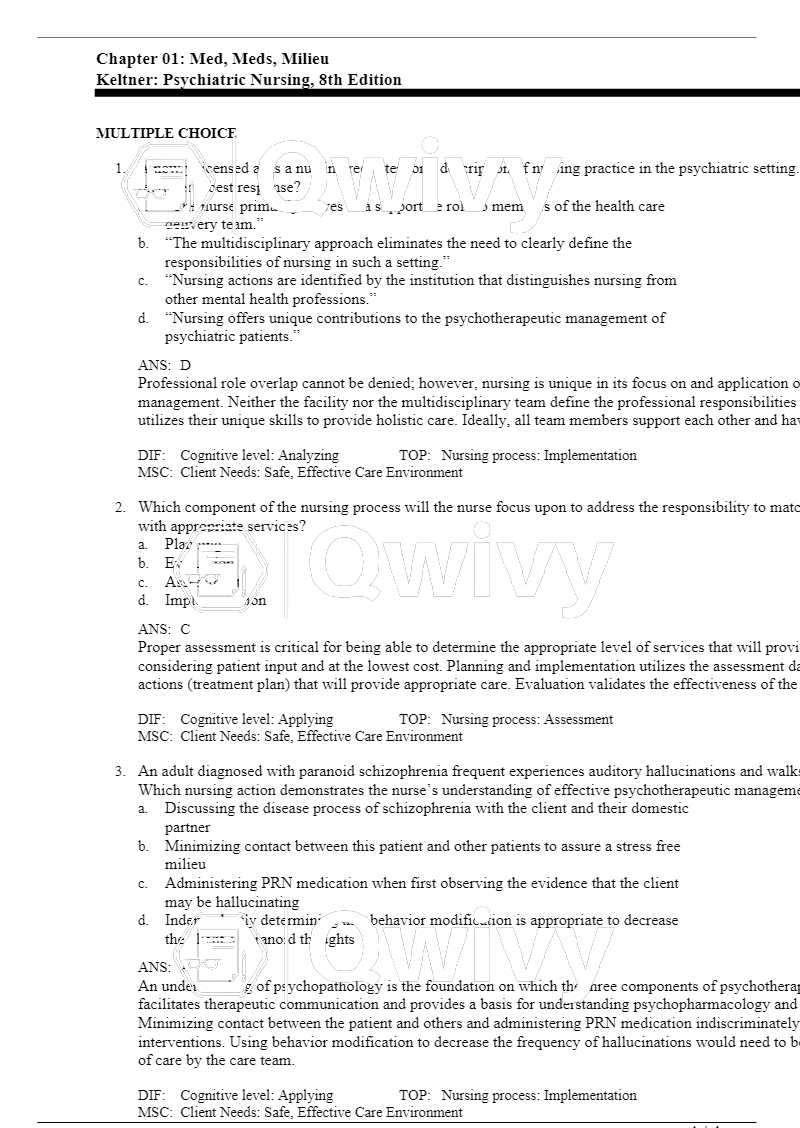
TEST BANK
INTERPERSONAL RELATIONSHIPS
8TH EDITION
Professional Communication Skills for Nurses
By: Elizabeth Arnold & Kathleen Boggs
TEST BANK
1 / 4
Interpersonal Relationships 8th Edition: Professional Communication Skills for Nurses by Arnold Test Bank
Chapters Contents:
Chapter 1. Historical Perspectives and Contemporary Dynamics
Chapter 2. Clarity and Safety in Communication
Chapter 3. Professional Guides for Nursing Communication
Chapter 4. Critical Judgment: Critical Thinking and Ethical Decision Making
Chapter 5. Developing Patient Centered Communication Skills
Chapter 6. Variation in Communication Styles
Chapter 7. Intercultural Communication
Chapter 8. Communicating in Groups
Chapter 9. Self-Concept in Professional Interpersonal Relationships
Chapter 10. Developing Patient Centered Therapeutic Relationships
Chapter 11. Bridges and Barriers in Therapeutic Relationships
Chapter 12. Communicating with Families
Chapter 13. Resolving Conflicts Between Nurse and Patient
Chapter 14. Communication Strategies for Health Promotion and Disease Prevention
Chapter 15. Communication in Health Teaching and Coaching
Chapter 16. Communication in Stressful Situations
Chapter 17. Communicating with Patients Experiencing Communication Deficits
Chapter 18. Communicating with Children
Chapter 19. Communicating with Older Adults
Chapter 20. Communicating with Patients in Crisis
Chapter 21. Communication in Palliative Care
Chapter 22. Role Relationship Communication within Nursing
Chapter 23. Interprofessional Communication
Chapter 24. Communicating for Continuity of Care
Chapter 25. Documentation in Health Information Technology Systems
Chapter 26. Health and Communication Technology
2 / 4
Interpersonal Relationships 8th Edition: Professional Communication Skills for Nurses by Arnold Test Bank
Chapter 01: Historical Perspectives and Contemporary Dynamics
Arnold: Interpersonal Relationships, 8th Edition
MULTIPLE CHOICE
1. When describing nursing to a group of nursing students, the nursing instructor lists all of the
following characteristics of nursing except
a. Historically nursing is as old as mankind.
b. Nursing was originally practiced informally by religious orders dedicated to care
ofthe sick.
c. Nursing was later practiced in the home by female caregivers with no
formaleducation.
d. Nursing has always been identifiable as a distinct occupation.
ANS: A
Historically, nursing is as old as humankind. Originally practiced informally by religious
orders dedicated to care of the sick and later in the home by female caregivers with no formal
education, nursing was not identifiable as a distinct occupation until the 1854 Crimean War.
There, Florence Nightingale’s Notes on Nursing introduced the world to the functional roles
of professional nursing and the need for formal education.
DIF: Cognitive Level: Comprehension TOP: Step of the Nursing Process: All Phases
MSC: Client Needs: Psychosocial Integrity
2. The nursing profession’s first nurse researcher, who served as an early advocate forhigh-quality
care and used statistical data to document the need for hand washing in preventing infection was?
a. Abraham Maslow.
b. Martha Rogers.
c. Hildegard Peplau.
d. Florence Nightingale.
ANS: D
O
An early advocate for high-quality care, Florence Nightingale’s use of statistical data to
document the need for hand washing in preventing infection marks her as the profession’s
first nurse researcher.
DIF: Cognitive Level: Knowledge TOP: Step of the Nursing Process: All Phases
MSC: Client Needs: Management of Care
3. Today, professional nursing education begins at the
a. Undergraduate level.
b. Graduate level.
c. Advanced practice level.
d. Administrative level.
ANS: A
3 / 4
Interpersonal Relationships 8th Edition: Professional Communication Skills for Nurses by Arnold Test Bank
Today, professional nursing education begins at the undergraduate level, with a growing
number of nurses choosing graduate studies to support differentiated practice roles and/or
research opportunities. Nurses are prepared to function as advanced practice nurse
practitioners, administrators, and educators.
DIF: Cognitive Level: Comprehension TOP: Step of the Nursing Process: All Phases
MSC: Client Needs: Management of Care
4. Nursing’s metaparadigm, or worldview, distinguishes the nursing profession from other
disciplines and emphasizes its unique functional characteristics. The four key concepts that
form the foundation for all nursing theories are
a. Caring, compassion, health promotion, and education.
b. Respect, integrity, honesty, and advocacy.
c. Person, environment, health, and nursing.
d. Nursing, teaching, caring, and health promotion.
ANS: C
Individual nursing theories represent different interpretations of the phenomenon of nursing,
but central constructs—person, environment, health, and nursing—are found in all theories
and models. They are referred to as nursing’s metaparadigm.
DIF: Cognitive Level: Knowledge TOP: Step of the Nursing Process: All Phases
MSC: Client Needs: Management of Care
5. When admitting a patient to the medical-surgical unit, the nurse asks the patient about cultural
Issues. The nurse is demonstrating use of the concept of
a. Person.
b. Environment
.
c. Health.
d. Nursing.
ANS: B
The concept of environment includes all cultural, developmental, and social determinants that
influence a patient’s health perceptions and behavior. A person is defined as the recipient of
nursing care, having unique bio-psycho-social and spiritual dimensions. The word health
derives from the word whole. Health is a multidimensional concept, having physical,
psychological, sociocultural, developmental, and spiritual characteristics. The World Health
Organization (WHO, 1946) defines health as “a state of complete physical, mental, social
well-being, not merely the absence of disease or infirmity.” Nursing includes the promotion of
health, prevention of illness, and the care of ill, disabled, and dying people.
DIF: Cognitive Level: Application TOP: Step of the Nursing Process: Assessment
MSC: Client Needs: Psychosocial Integrity
6. A young mother tells the nurse, “I’m worried because my son needs a blood transfusion. I
don’t know what to do, because blood transfusions cause AIDS.” Which central nursing
construct is represented in this situation?
a. Environment
b. Caring
c. Health
d. Person
Powered by qwivy (www.qwivy .org)
4 / 4
| Version | latest |
| Category | TEST BANK |
| Pages | 181 |
| Language | English |
| Comments | 0 |
| Sales | 0 |















{{ userMessage }}





